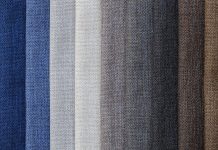I sort of feel like this has been done already (um, probably because it has—see the links at the end of this post!), but so may of you have asked me for a tutorial on cutting ENJE roller shades from IKEA that I figured I’d try to document the whole process from start to finish as best as I can. I swear it’s REALLY EASY, even though I have an unfortunate knack for using a lot of words to describe very simple things (I was really annoying in college, but you probably guessed that already).
If you, like me, have 40, 985, 934 windows in your house that are all odd, non-standard sizes, you’ve probably discovered that custom shades are ridiculously expensive. Like, $100-300 per window. Multiply that by 40, 985, 934, and you’ve got…um…empty pockets. Enter ENJE. They look really good, function well (even the ones I’ve opened and closed several times a day for more than a year still roll smoothly), filter light beautifully while providing privacy, and they’re affordable. And you can cut them to fit, which is why we’re all here today.
Supplies:
• An ENJE shade (you probably guessed that)
• A metal ruler/straightedge
• Pliers or a wrench or really strong fingers
• A sharp pencil
• An X-Acto knife
• A decent pair of scissors (preferably fabric shears)
• Painter’s tape
• A jigsaw with hacksaw blade or a manual hacksaw or a Dremel with a metal-cutting blade*
*Don’t fret about the saw. You can get a manual hacksaw for less than , and you’ll use it all the time. If you already own a jigsaw, though, spring for a hacksaw blade.
When you open up the package the shade comes in, you’ll find a long strip of cardboard with the product information printed on it. Don’t throw it away. It’s a template (see those holes at either end?), and aside from functioning as a guide for drilling mounting holes, it’s very handy for determining exactly how much to trim off of your shade in order for it to fit nicely in your window.
First of all, don’t take the measurements on the IKEA website and the ENJE packaging as gospel, especially if you’re in the US (or another non-metric country). They’re converted to inches from centimeters, and the numbers are usually rounded up or down a bit. 1/32″ isn’t a big deal when you’re talking about a sofa, but window frames aren’t flexible! Instead of going off the printed info, measure the cardboard template yourself and make note of the number.
I’ll bet you’re wondering if I went to MIT, right?
Here’s me doing basic math. Snicker all you want, but I have to write everything down (and use circles and arrows), or else I get all confused and make mistakes. In case you can’t figure it out, the first number is the measurement of the cardboard template (i.e., the actual width of the entire ENJE fixture, including the mounting hardware), and the second number is the interior space of my window frame. The third number is the difference between the two—in other words, that’s the amount I need to cut off of the shade in order for it to fit perfectly.




















